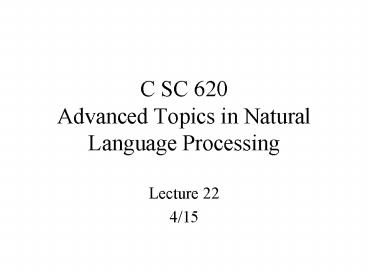C SC 620 Advanced Topics in Natural Language Processing PowerPoint PPT Presentation
Title: C SC 620 Advanced Topics in Natural Language Processing
1
C SC 620Advanced Topics in Natural Language
Processing
- Lecture 22
- 4/15
2
Reading List
- Readings in Machine Translation, Eds. Nirenburg,
S. et al. MIT Press 2003. - 19. Montague Grammar and Machine Translation.
Landsbergen, J. - 20. Dialogue Translation vs. Text Translation
Interpretation Based Approach. Tsujii, J.-I. And
M. Nagao - 21. Translation by Structural Correspondences.
Kaplan, R. et al. - 22. Pros and Cons of the Pivot and Transfer
Approaches in Multilingual Machine Translation.
Boitet, C. - 31. A Framework of a Mechanical Translation
between Japanese and English by Analogy
Principle. Nagao, M. - 32. A Statistical Approach to Machine
Translation. Brown, P. F. et al.
3
(No Transcript)
4
(No Transcript)
5
(No Transcript)
6
- Similar to the Phraselator
7
(No Transcript)
8
(No Transcript)
9
(No Transcript)
10
(No Transcript)
11
(No Transcript)
12
(No Transcript)
13
Paper 22. Pros and Cons of the Pivot and Transfer
Approaches in Multilingual Machine Translation.
Boitet, C.
- Time 90s
- Introduction Why is the Pivot Approach Not
Universally Used? - Pivot (interlingua) O(n) parsers/analyzers
- Transfer O(n2) parsers/analyzers
- n number of languages
- Pivot dictionaries monolingual
- Transfer dictionaries bilingual
14
Paper 22. Pros and Cons of the Pivot and Transfer
Approaches in Multilingual Machine Translation.
Boitet, C.
- Pure Pivot Approaches
- Independent pivot lexicon
- Universal notation for determination,
quantification, actualization (time/modality/aspec
t), thematization, etc. - I.1 Pure Pivot Lexicons are Challenging
- 1.1 But Specific of a Domain (Interpretation
Language) - May be possible to define a completely artificial
language for a fixed and restricted domain - TITUS system textile domain
- 1.2 Or Specific of a Language Group (Standard
Language) - Standard Language e.g. English
- Double translations for all pairs of languages
not containing the pivot - No implementation known
- Idiosyncratic gap between language families
15
Paper 22. Pros and Cons of the Pivot and Transfer
Approaches in Multilingual Machine Translation.
Boitet, C.
- 1.2 Or Specific of a Language Group (Standard
Language) - Artificial Language e.g. Esperanto
- BSO project
- Double translations for all pairs of languages
- Lack of sufficient technical vocabulary
- need about 50,000 terms in any typical technical
domain - Esperanto too small
- Idiosyncratic gap still exists
- Esperanto borrows from several language families
- but unavoidable that many distinctions and ways
of expression are left out - mur (French) - wall
- muro (Italian, seen from outside), parete (seen
from inside)
16
Paper 22. Pros and Cons of the Pivot and Transfer
Approaches in Multilingual Machine Translation.
Boitet, C.
- 1.3 And Always Very Difficult to Construct
(Conceptual Decomposition/Enumeration) - Define small number of conceptual primitives and
decompose all lexical items in terms of them - Conceptual dependency graphs will be huge
- Use subroutines - conceptual enumeration
- Japanese CICC project 250,000 concepts
- Construction process is non-montonic
- new concept, revise dictionary for all languages
- Difficult to see if concept already exists if its
name is difficult to guess - pros and cons translated into another language
17
Paper 22. Pros and Cons of the Pivot and Transfer
Approaches in Multilingual Machine Translation.
Boitet, C.
- I.2 Pure Pivot Structure Loses Information
- Extremely rare that two different terms or
constructions of a language are completely
synonymous - Unavoidable information useful for quality
translation will be lost - 2.1 At the Lexical Level
- wall -gt wall seen from outside -gt muro
- wall (seen from outside) -gt ???
- muro -gt wall
- parete -gt wall (distinction lost)
- 2.2 At the Lower Interpretation Levels (Style)
- One obtains paraphrases
- Impossible to parallel styles as all trace of the
source expression is lost - 2.3 At Non-Universal Grammatical Levels
- All or nothing problem
18
Paper 22. Pros and Cons of the Pivot and Transfer
Approaches in Multilingual Machine Translation.
Boitet, C.
- II. Transfer Approaches
- Avoid Pivot difficulties
- 1 -gt many or many -gt 1 situations
- II.1 The Hybrid Approaches May Be Worse, Because
the Square Problem Remains - Lexical language-specific
- Grammatical and relational symbols are universal
- Big transfer dictionary needed
- 1.1 If the Lexicons are Only Monolingual (CETA)
- Grenoble group (CETA)
- Hybrid pivot approach
19
Paper 22. Pros and Cons of the Pivot and Transfer
Approaches in Multilingual Machine Translation.
Boitet, C.
- 1.2 And Even If Some Part Becomes Universal
(EUROTRA) - EUROTRA (1983)
- 9 languages
- linguistic development scattered across 11
countries - transfer approach
- part number approach for technical terms
- II.2 Transfer Architectures Using m-Structures
- Sequential or
- Integrated approach using a multilevel structural
descriptor - 2.1 Allow to Reach a Higher Quality
- no universal notation for tense/aspect/modality
- source language specific
- 2.2 May be Preferable in 1-gtm Situations
- Big firms - documentation produced in one
language
20
Paper 22. Pros and Cons of the Pivot and Transfer
Approaches in Multilingual Machine Translation.
Boitet, C.
- III. Both Approaches for the Future?
- III.1 Pivot
- 1.1 Domain-Specific Pivots New Applications?
- CAD/CAM and expert systems generation from
knowledge base - 1.2 Conceptual Decomposition/Enumeration a
Challenge - EDR
- Multilingual conceptual database (EuroWordNet?)
21
Paper 22. Pros and Cons of the Pivot and Transfer
Approaches in Multilingual Machine Translation.
Boitet, C.
- III.2 Transfer
- 2.1 Conversion from First to Second Generation
- SYSTRAN (used in babelfish.altavista)
- 1G to 2G (?), see comments on CETA (pg.276)
- Concepts dictionaries
- 2.2 Composition in nlt-gtn Situations The
Structured Language Approach - Relay translation
- 4 Romance languages
- 4 Germanic languages
- Greek

